Project Management Practices: Analysis of Three Case Studies Report
VerifiedAdded on 2022/08/20
|47
|13816
|14
Report
AI Summary
This report provides a comprehensive analysis of project management practices through three distinct case studies. The first case study examines a lecture capture upgrade project at an Australian university, highlighting issues related to scheduling, quality, and risk management. The second case study delves into the Sydney Opera House project, exploring its financial and managerial challenges. The final case study focuses on the severe exploitation of foreign workers in Australia within a construction project, analyzing the role of subcontractors and union involvement. The report employs observation techniques for research methodology, identifying problems, analyzing the root causes, and offering recommendations for improved project management. The analysis covers project schedule, quality, and risk management, providing insights into potential failures and success factors within each case study. The report concludes with a synthesis of findings and recommendations for enhancing project outcomes, emphasizing the importance of effective planning, risk mitigation, and stakeholder management.
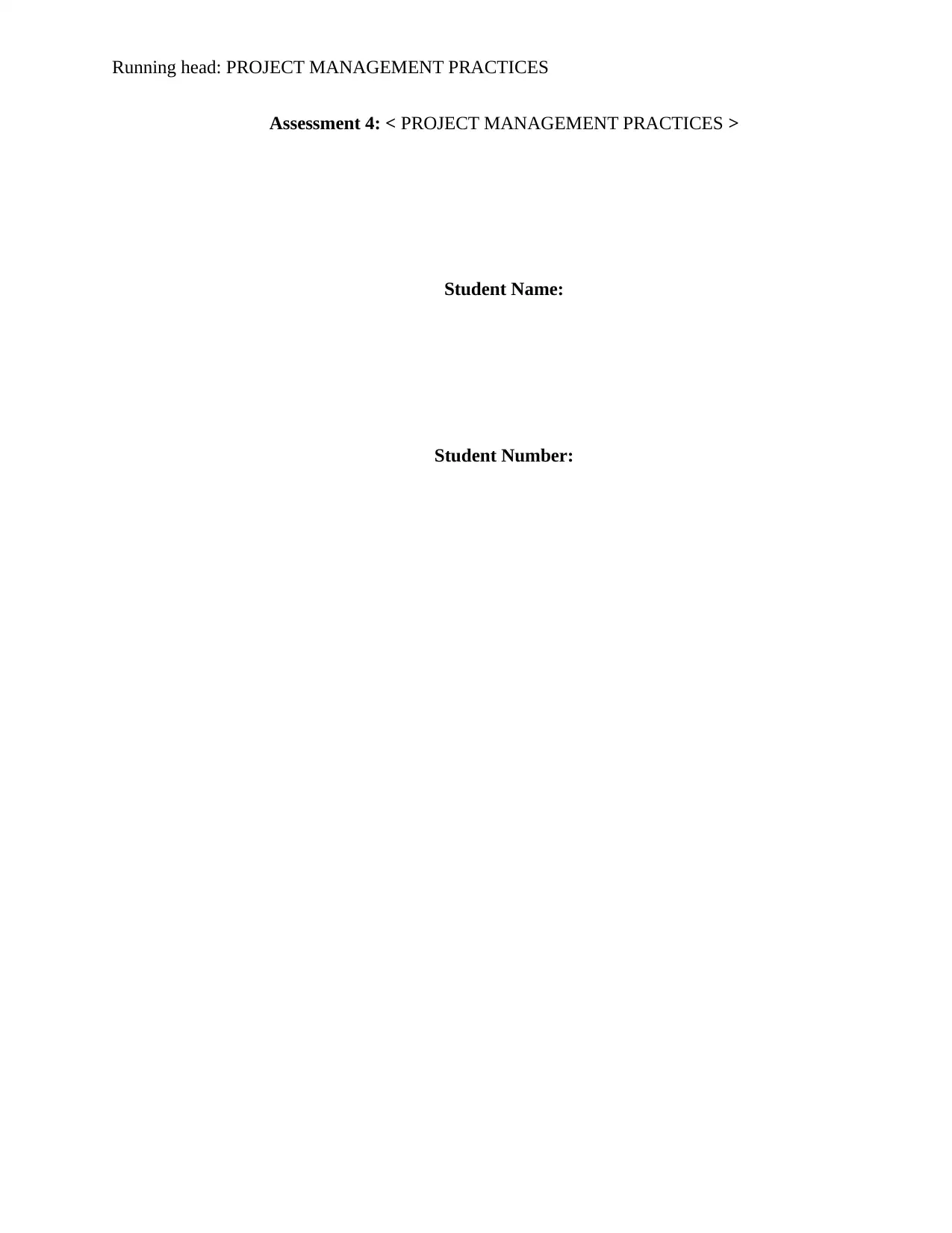
Running head: PROJECT MANAGEMENT PRACTICES
Assessment 4: < PROJECT MANAGEMENT PRACTICES >
Student Name:
Student Number:
Assessment 4: < PROJECT MANAGEMENT PRACTICES >
Student Name:
Student Number:
Paraphrase This Document
Need a fresh take? Get an instant paraphrase of this document with our AI Paraphraser
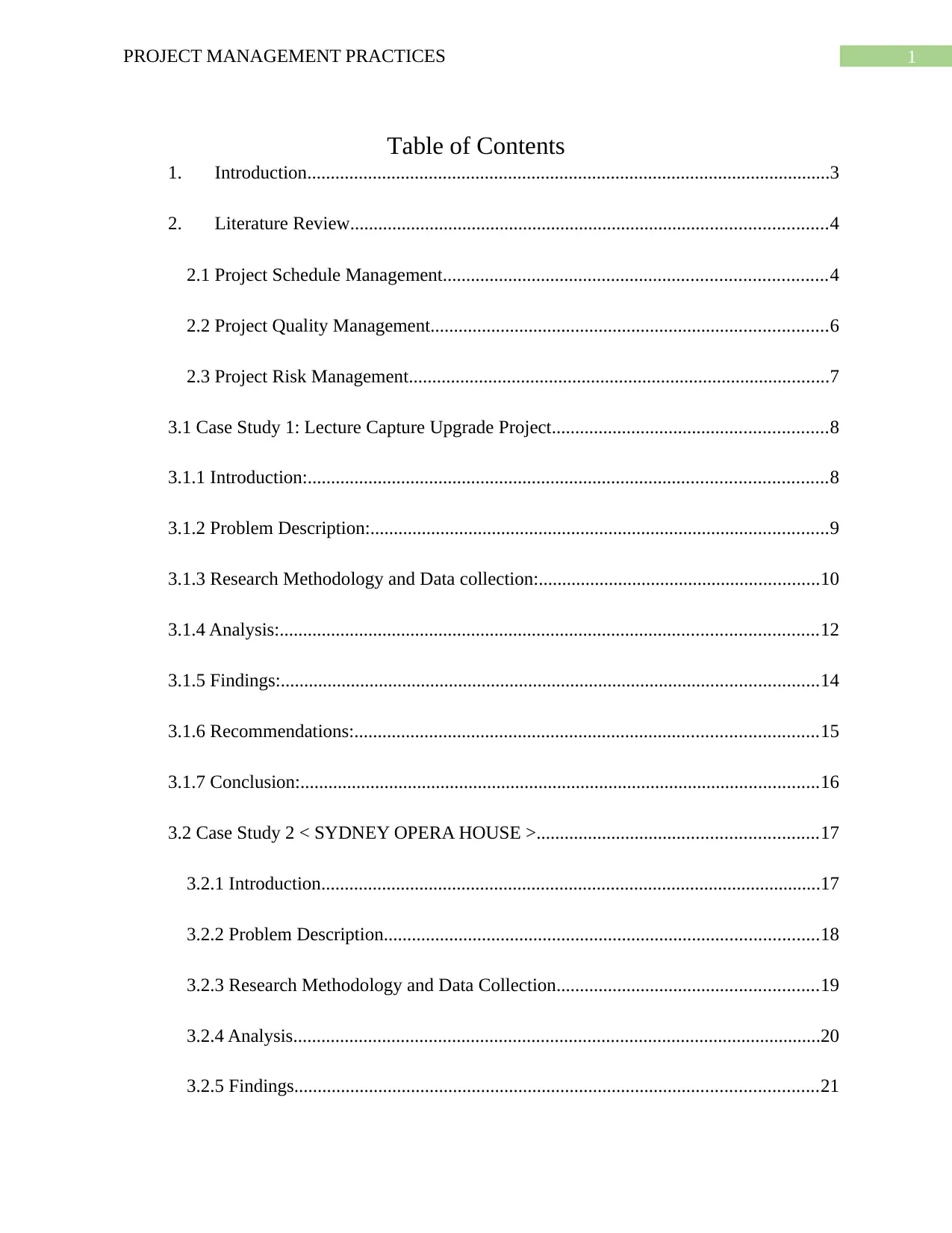
1PROJECT MANAGEMENT PRACTICES
Table of Contents
1. Introduction................................................................................................................3
2. Literature Review......................................................................................................4
2.1 Project Schedule Management..................................................................................4
2.2 Project Quality Management.....................................................................................6
2.3 Project Risk Management..........................................................................................7
3.1 Case Study 1: Lecture Capture Upgrade Project...........................................................8
3.1.1 Introduction:...............................................................................................................8
3.1.2 Problem Description:..................................................................................................9
3.1.3 Research Methodology and Data collection:............................................................10
3.1.4 Analysis:...................................................................................................................12
3.1.5 Findings:...................................................................................................................14
3.1.6 Recommendations:...................................................................................................15
3.1.7 Conclusion:...............................................................................................................16
3.2 Case Study 2 < SYDNEY OPERA HOUSE >............................................................17
3.2.1 Introduction...........................................................................................................17
3.2.2 Problem Description.............................................................................................18
3.2.3 Research Methodology and Data Collection........................................................19
3.2.4 Analysis.................................................................................................................20
3.2.5 Findings................................................................................................................21
Table of Contents
1. Introduction................................................................................................................3
2. Literature Review......................................................................................................4
2.1 Project Schedule Management..................................................................................4
2.2 Project Quality Management.....................................................................................6
2.3 Project Risk Management..........................................................................................7
3.1 Case Study 1: Lecture Capture Upgrade Project...........................................................8
3.1.1 Introduction:...............................................................................................................8
3.1.2 Problem Description:..................................................................................................9
3.1.3 Research Methodology and Data collection:............................................................10
3.1.4 Analysis:...................................................................................................................12
3.1.5 Findings:...................................................................................................................14
3.1.6 Recommendations:...................................................................................................15
3.1.7 Conclusion:...............................................................................................................16
3.2 Case Study 2 < SYDNEY OPERA HOUSE >............................................................17
3.2.1 Introduction...........................................................................................................17
3.2.2 Problem Description.............................................................................................18
3.2.3 Research Methodology and Data Collection........................................................19
3.2.4 Analysis.................................................................................................................20
3.2.5 Findings................................................................................................................21
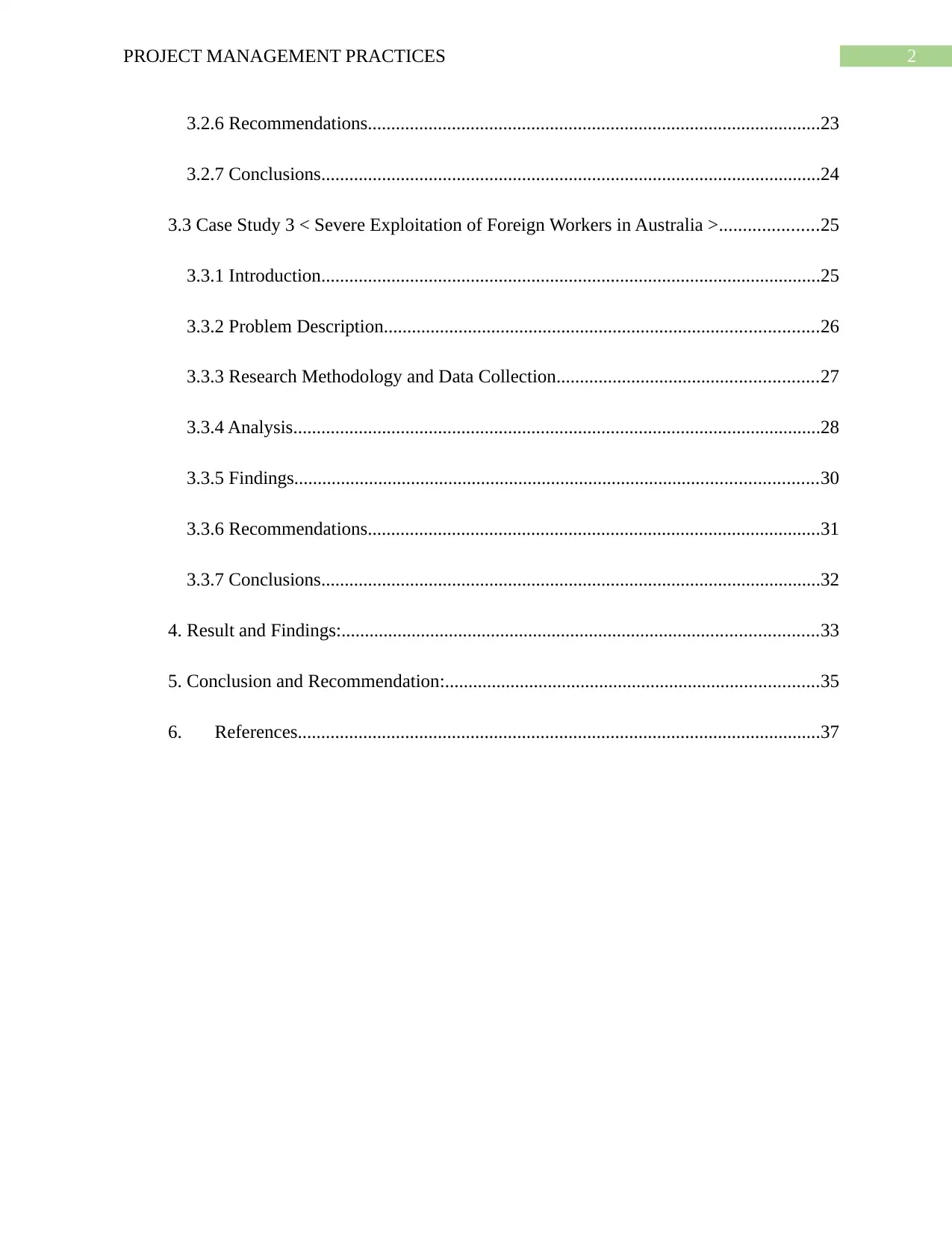
2PROJECT MANAGEMENT PRACTICES
3.2.6 Recommendations.................................................................................................23
3.2.7 Conclusions...........................................................................................................24
3.3 Case Study 3 < Severe Exploitation of Foreign Workers in Australia >.....................25
3.3.1 Introduction...........................................................................................................25
3.3.2 Problem Description.............................................................................................26
3.3.3 Research Methodology and Data Collection........................................................27
3.3.4 Analysis.................................................................................................................28
3.3.5 Findings................................................................................................................30
3.3.6 Recommendations.................................................................................................31
3.3.7 Conclusions...........................................................................................................32
4. Result and Findings:......................................................................................................33
5. Conclusion and Recommendation:................................................................................35
6. References................................................................................................................37
3.2.6 Recommendations.................................................................................................23
3.2.7 Conclusions...........................................................................................................24
3.3 Case Study 3 < Severe Exploitation of Foreign Workers in Australia >.....................25
3.3.1 Introduction...........................................................................................................25
3.3.2 Problem Description.............................................................................................26
3.3.3 Research Methodology and Data Collection........................................................27
3.3.4 Analysis.................................................................................................................28
3.3.5 Findings................................................................................................................30
3.3.6 Recommendations.................................................................................................31
3.3.7 Conclusions...........................................................................................................32
4. Result and Findings:......................................................................................................33
5. Conclusion and Recommendation:................................................................................35
6. References................................................................................................................37
⊘ This is a preview!⊘
Do you want full access?
Subscribe today to unlock all pages.

Trusted by 1+ million students worldwide
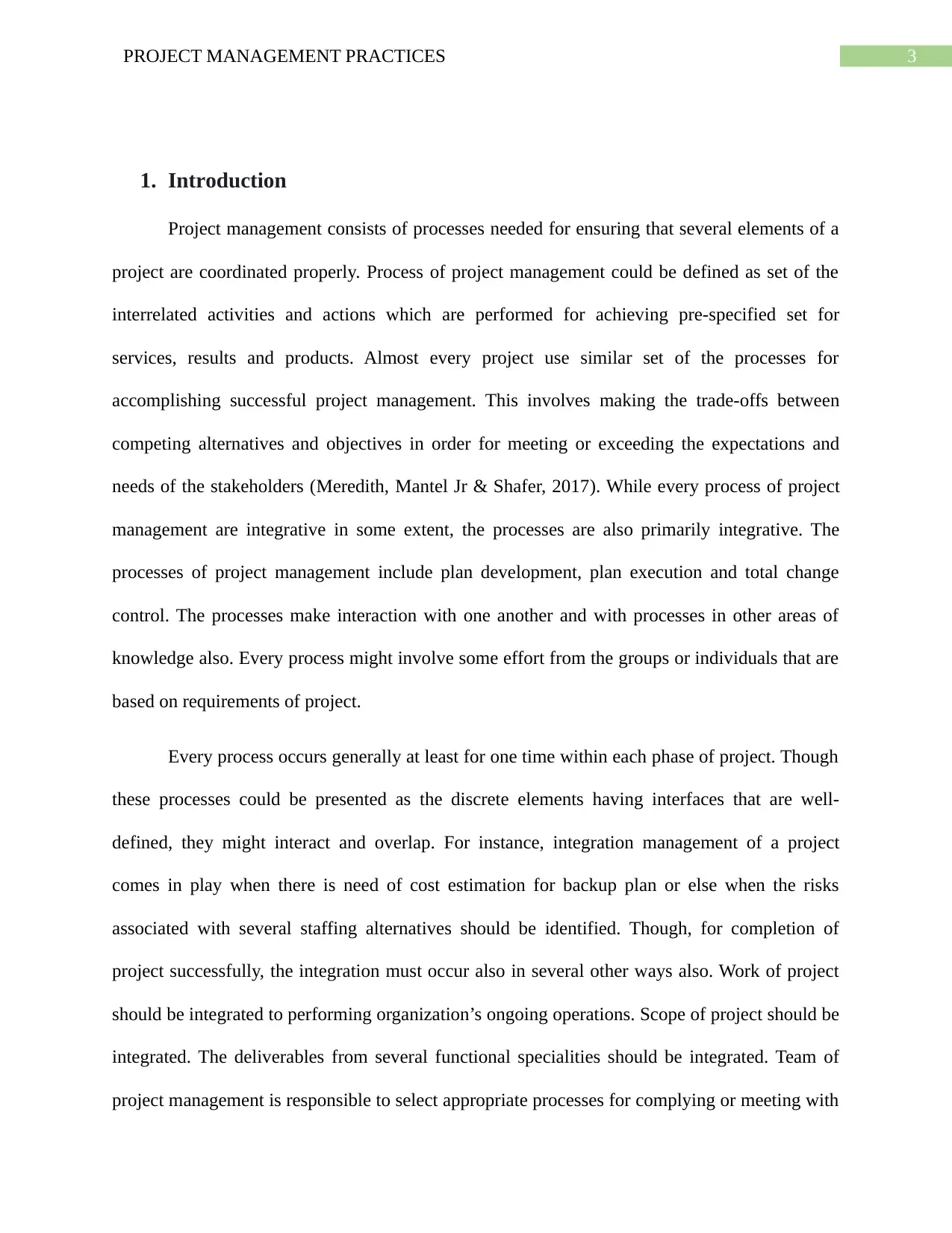
3PROJECT MANAGEMENT PRACTICES
1. Introduction
Project management consists of processes needed for ensuring that several elements of a
project are coordinated properly. Process of project management could be defined as set of the
interrelated activities and actions which are performed for achieving pre-specified set for
services, results and products. Almost every project use similar set of the processes for
accomplishing successful project management. This involves making the trade-offs between
competing alternatives and objectives in order for meeting or exceeding the expectations and
needs of the stakeholders (Meredith, Mantel Jr & Shafer, 2017). While every process of project
management are integrative in some extent, the processes are also primarily integrative. The
processes of project management include plan development, plan execution and total change
control. The processes make interaction with one another and with processes in other areas of
knowledge also. Every process might involve some effort from the groups or individuals that are
based on requirements of project.
Every process occurs generally at least for one time within each phase of project. Though
these processes could be presented as the discrete elements having interfaces that are well-
defined, they might interact and overlap. For instance, integration management of a project
comes in play when there is need of cost estimation for backup plan or else when the risks
associated with several staffing alternatives should be identified. Though, for completion of
project successfully, the integration must occur also in several other ways also. Work of project
should be integrated to performing organization’s ongoing operations. Scope of project should be
integrated. The deliverables from several functional specialities should be integrated. Team of
project management is responsible to select appropriate processes for complying or meeting with
1. Introduction
Project management consists of processes needed for ensuring that several elements of a
project are coordinated properly. Process of project management could be defined as set of the
interrelated activities and actions which are performed for achieving pre-specified set for
services, results and products. Almost every project use similar set of the processes for
accomplishing successful project management. This involves making the trade-offs between
competing alternatives and objectives in order for meeting or exceeding the expectations and
needs of the stakeholders (Meredith, Mantel Jr & Shafer, 2017). While every process of project
management are integrative in some extent, the processes are also primarily integrative. The
processes of project management include plan development, plan execution and total change
control. The processes make interaction with one another and with processes in other areas of
knowledge also. Every process might involve some effort from the groups or individuals that are
based on requirements of project.
Every process occurs generally at least for one time within each phase of project. Though
these processes could be presented as the discrete elements having interfaces that are well-
defined, they might interact and overlap. For instance, integration management of a project
comes in play when there is need of cost estimation for backup plan or else when the risks
associated with several staffing alternatives should be identified. Though, for completion of
project successfully, the integration must occur also in several other ways also. Work of project
should be integrated to performing organization’s ongoing operations. Scope of project should be
integrated. The deliverables from several functional specialities should be integrated. Team of
project management is responsible to select appropriate processes for complying or meeting with
Paraphrase This Document
Need a fresh take? Get an instant paraphrase of this document with our AI Paraphraser
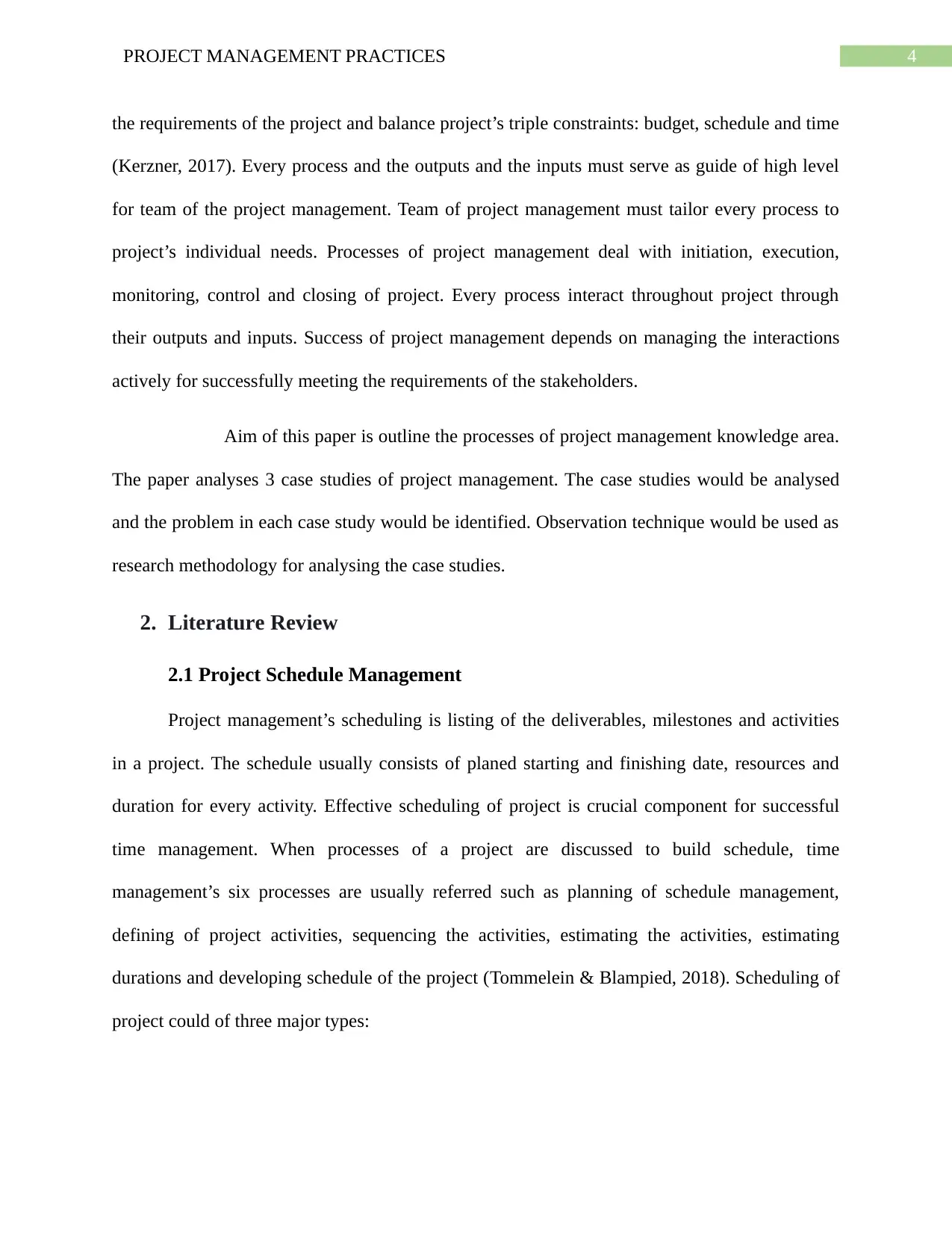
4PROJECT MANAGEMENT PRACTICES
the requirements of the project and balance project’s triple constraints: budget, schedule and time
(Kerzner, 2017). Every process and the outputs and the inputs must serve as guide of high level
for team of the project management. Team of project management must tailor every process to
project’s individual needs. Processes of project management deal with initiation, execution,
monitoring, control and closing of project. Every process interact throughout project through
their outputs and inputs. Success of project management depends on managing the interactions
actively for successfully meeting the requirements of the stakeholders.
Aim of this paper is outline the processes of project management knowledge area.
The paper analyses 3 case studies of project management. The case studies would be analysed
and the problem in each case study would be identified. Observation technique would be used as
research methodology for analysing the case studies.
2. Literature Review
2.1 Project Schedule Management
Project management’s scheduling is listing of the deliverables, milestones and activities
in a project. The schedule usually consists of planed starting and finishing date, resources and
duration for every activity. Effective scheduling of project is crucial component for successful
time management. When processes of a project are discussed to build schedule, time
management’s six processes are usually referred such as planning of schedule management,
defining of project activities, sequencing the activities, estimating the activities, estimating
durations and developing schedule of the project (Tommelein & Blampied, 2018). Scheduling of
project could of three major types:
the requirements of the project and balance project’s triple constraints: budget, schedule and time
(Kerzner, 2017). Every process and the outputs and the inputs must serve as guide of high level
for team of the project management. Team of project management must tailor every process to
project’s individual needs. Processes of project management deal with initiation, execution,
monitoring, control and closing of project. Every process interact throughout project through
their outputs and inputs. Success of project management depends on managing the interactions
actively for successfully meeting the requirements of the stakeholders.
Aim of this paper is outline the processes of project management knowledge area.
The paper analyses 3 case studies of project management. The case studies would be analysed
and the problem in each case study would be identified. Observation technique would be used as
research methodology for analysing the case studies.
2. Literature Review
2.1 Project Schedule Management
Project management’s scheduling is listing of the deliverables, milestones and activities
in a project. The schedule usually consists of planed starting and finishing date, resources and
duration for every activity. Effective scheduling of project is crucial component for successful
time management. When processes of a project are discussed to build schedule, time
management’s six processes are usually referred such as planning of schedule management,
defining of project activities, sequencing the activities, estimating the activities, estimating
durations and developing schedule of the project (Tommelein & Blampied, 2018). Scheduling of
project could of three major types:
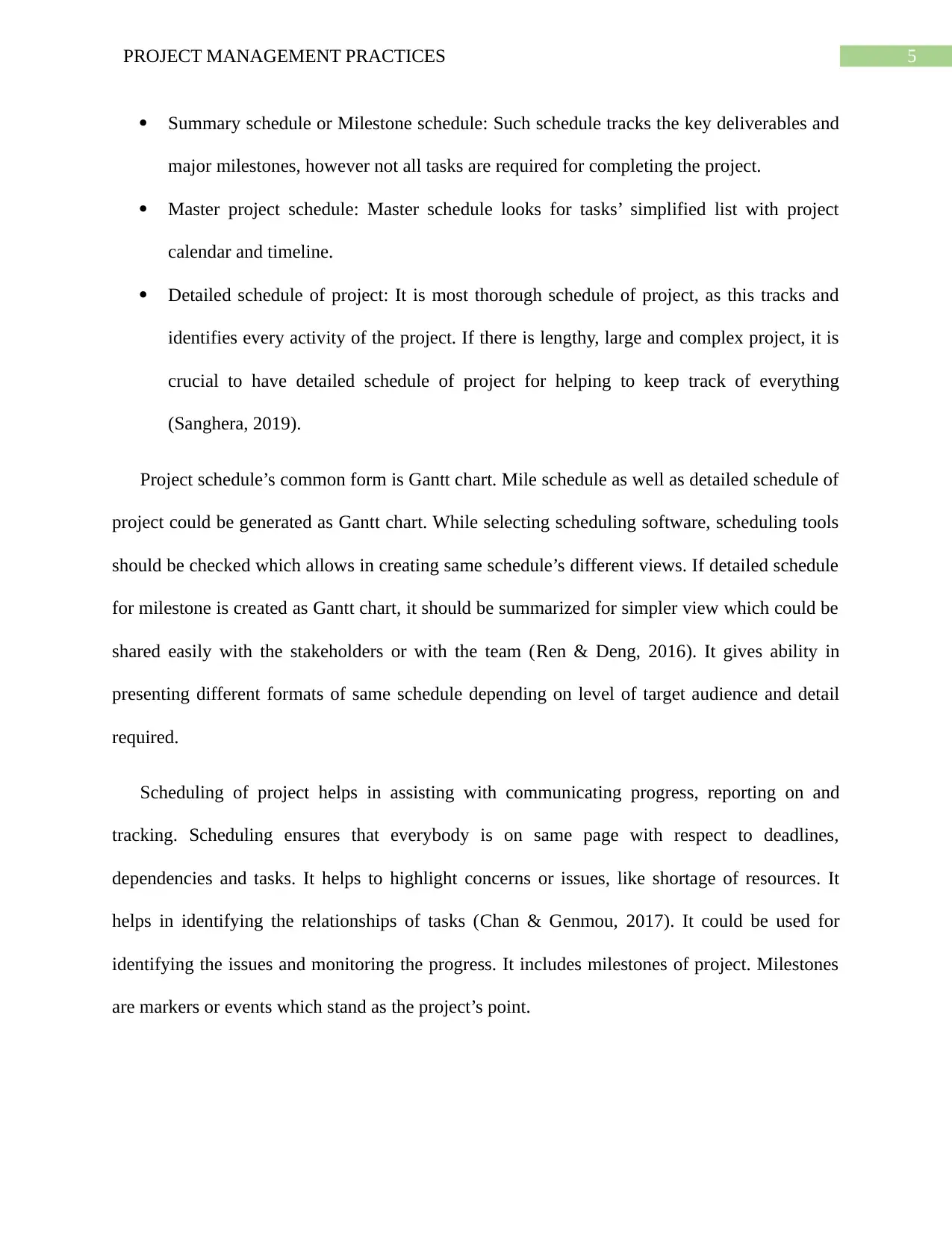
5PROJECT MANAGEMENT PRACTICES
Summary schedule or Milestone schedule: Such schedule tracks the key deliverables and
major milestones, however not all tasks are required for completing the project.
Master project schedule: Master schedule looks for tasks’ simplified list with project
calendar and timeline.
Detailed schedule of project: It is most thorough schedule of project, as this tracks and
identifies every activity of the project. If there is lengthy, large and complex project, it is
crucial to have detailed schedule of project for helping to keep track of everything
(Sanghera, 2019).
Project schedule’s common form is Gantt chart. Mile schedule as well as detailed schedule of
project could be generated as Gantt chart. While selecting scheduling software, scheduling tools
should be checked which allows in creating same schedule’s different views. If detailed schedule
for milestone is created as Gantt chart, it should be summarized for simpler view which could be
shared easily with the stakeholders or with the team (Ren & Deng, 2016). It gives ability in
presenting different formats of same schedule depending on level of target audience and detail
required.
Scheduling of project helps in assisting with communicating progress, reporting on and
tracking. Scheduling ensures that everybody is on same page with respect to deadlines,
dependencies and tasks. It helps to highlight concerns or issues, like shortage of resources. It
helps in identifying the relationships of tasks (Chan & Genmou, 2017). It could be used for
identifying the issues and monitoring the progress. It includes milestones of project. Milestones
are markers or events which stand as the project’s point.
Summary schedule or Milestone schedule: Such schedule tracks the key deliverables and
major milestones, however not all tasks are required for completing the project.
Master project schedule: Master schedule looks for tasks’ simplified list with project
calendar and timeline.
Detailed schedule of project: It is most thorough schedule of project, as this tracks and
identifies every activity of the project. If there is lengthy, large and complex project, it is
crucial to have detailed schedule of project for helping to keep track of everything
(Sanghera, 2019).
Project schedule’s common form is Gantt chart. Mile schedule as well as detailed schedule of
project could be generated as Gantt chart. While selecting scheduling software, scheduling tools
should be checked which allows in creating same schedule’s different views. If detailed schedule
for milestone is created as Gantt chart, it should be summarized for simpler view which could be
shared easily with the stakeholders or with the team (Ren & Deng, 2016). It gives ability in
presenting different formats of same schedule depending on level of target audience and detail
required.
Scheduling of project helps in assisting with communicating progress, reporting on and
tracking. Scheduling ensures that everybody is on same page with respect to deadlines,
dependencies and tasks. It helps to highlight concerns or issues, like shortage of resources. It
helps in identifying the relationships of tasks (Chan & Genmou, 2017). It could be used for
identifying the issues and monitoring the progress. It includes milestones of project. Milestones
are markers or events which stand as the project’s point.
⊘ This is a preview!⊘
Do you want full access?
Subscribe today to unlock all pages.

Trusted by 1+ million students worldwide
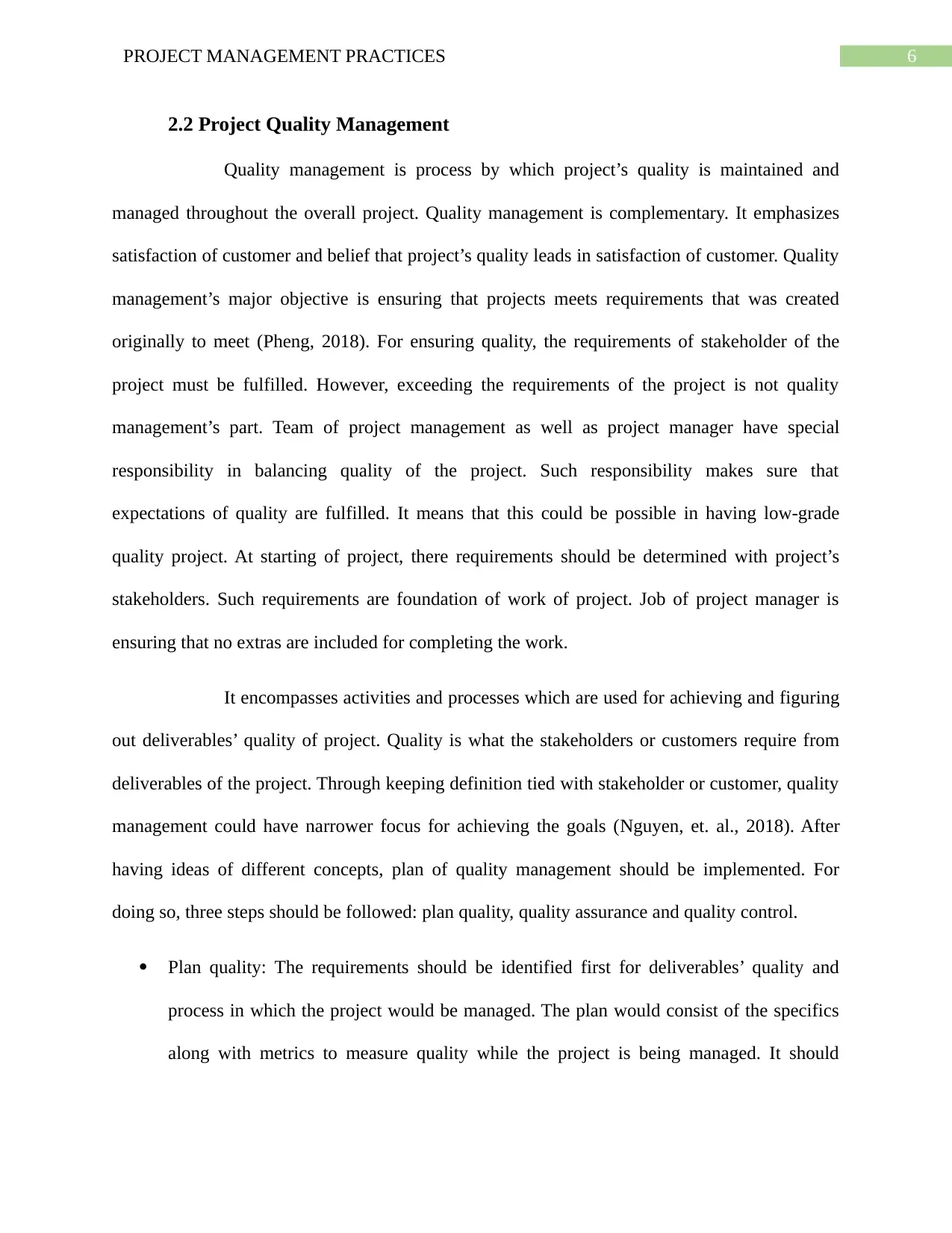
6PROJECT MANAGEMENT PRACTICES
2.2 Project Quality Management
Quality management is process by which project’s quality is maintained and
managed throughout the overall project. Quality management is complementary. It emphasizes
satisfaction of customer and belief that project’s quality leads in satisfaction of customer. Quality
management’s major objective is ensuring that projects meets requirements that was created
originally to meet (Pheng, 2018). For ensuring quality, the requirements of stakeholder of the
project must be fulfilled. However, exceeding the requirements of the project is not quality
management’s part. Team of project management as well as project manager have special
responsibility in balancing quality of the project. Such responsibility makes sure that
expectations of quality are fulfilled. It means that this could be possible in having low-grade
quality project. At starting of project, there requirements should be determined with project’s
stakeholders. Such requirements are foundation of work of project. Job of project manager is
ensuring that no extras are included for completing the work.
It encompasses activities and processes which are used for achieving and figuring
out deliverables’ quality of project. Quality is what the stakeholders or customers require from
deliverables of the project. Through keeping definition tied with stakeholder or customer, quality
management could have narrower focus for achieving the goals (Nguyen, et. al., 2018). After
having ideas of different concepts, plan of quality management should be implemented. For
doing so, three steps should be followed: plan quality, quality assurance and quality control.
Plan quality: The requirements should be identified first for deliverables’ quality and
process in which the project would be managed. The plan would consist of the specifics
along with metrics to measure quality while the project is being managed. It should
2.2 Project Quality Management
Quality management is process by which project’s quality is maintained and
managed throughout the overall project. Quality management is complementary. It emphasizes
satisfaction of customer and belief that project’s quality leads in satisfaction of customer. Quality
management’s major objective is ensuring that projects meets requirements that was created
originally to meet (Pheng, 2018). For ensuring quality, the requirements of stakeholder of the
project must be fulfilled. However, exceeding the requirements of the project is not quality
management’s part. Team of project management as well as project manager have special
responsibility in balancing quality of the project. Such responsibility makes sure that
expectations of quality are fulfilled. It means that this could be possible in having low-grade
quality project. At starting of project, there requirements should be determined with project’s
stakeholders. Such requirements are foundation of work of project. Job of project manager is
ensuring that no extras are included for completing the work.
It encompasses activities and processes which are used for achieving and figuring
out deliverables’ quality of project. Quality is what the stakeholders or customers require from
deliverables of the project. Through keeping definition tied with stakeholder or customer, quality
management could have narrower focus for achieving the goals (Nguyen, et. al., 2018). After
having ideas of different concepts, plan of quality management should be implemented. For
doing so, three steps should be followed: plan quality, quality assurance and quality control.
Plan quality: The requirements should be identified first for deliverables’ quality and
process in which the project would be managed. The plan would consist of the specifics
along with metrics to measure quality while the project is being managed. It should
Paraphrase This Document
Need a fresh take? Get an instant paraphrase of this document with our AI Paraphraser
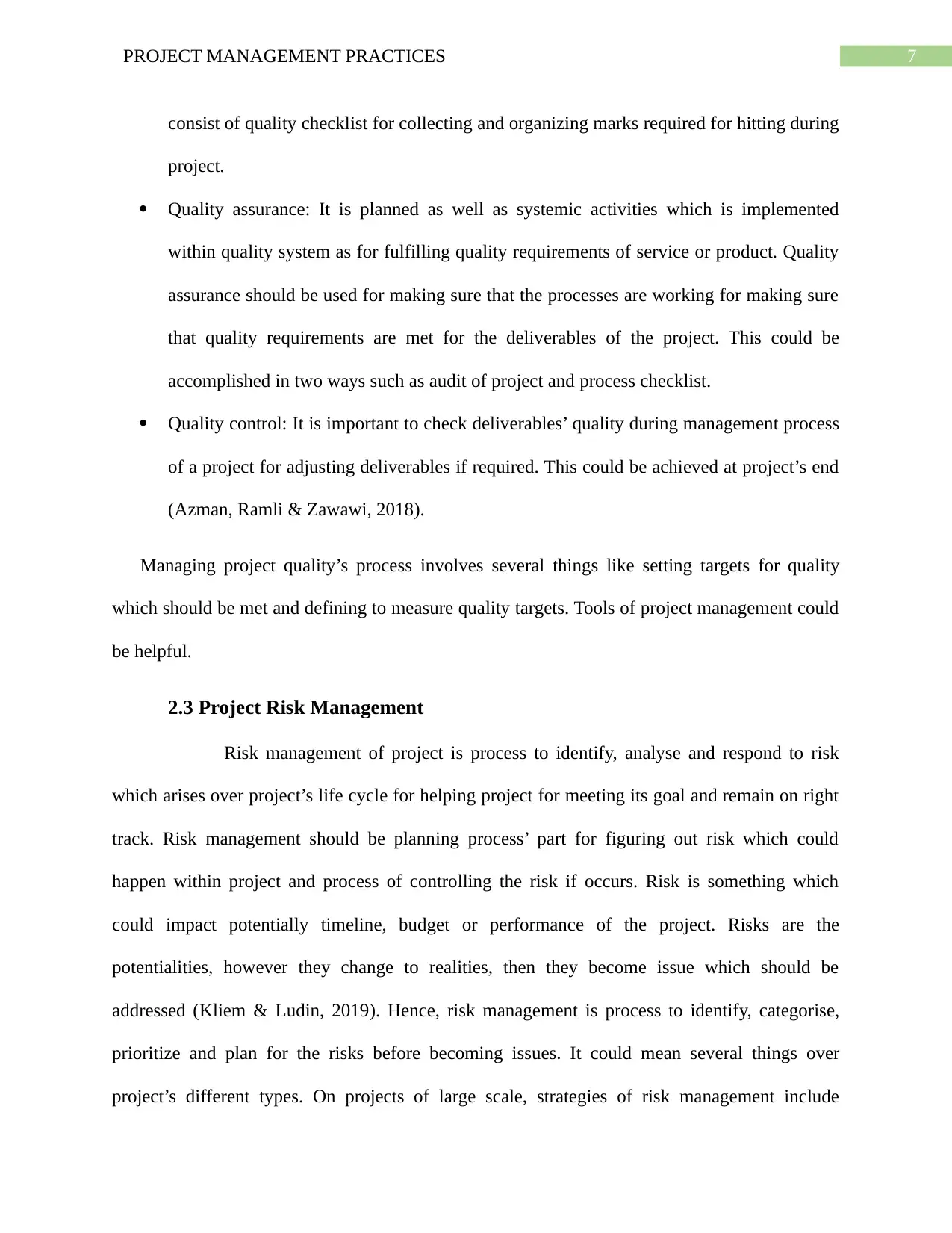
7PROJECT MANAGEMENT PRACTICES
consist of quality checklist for collecting and organizing marks required for hitting during
project.
Quality assurance: It is planned as well as systemic activities which is implemented
within quality system as for fulfilling quality requirements of service or product. Quality
assurance should be used for making sure that the processes are working for making sure
that quality requirements are met for the deliverables of the project. This could be
accomplished in two ways such as audit of project and process checklist.
Quality control: It is important to check deliverables’ quality during management process
of a project for adjusting deliverables if required. This could be achieved at project’s end
(Azman, Ramli & Zawawi, 2018).
Managing project quality’s process involves several things like setting targets for quality
which should be met and defining to measure quality targets. Tools of project management could
be helpful.
2.3 Project Risk Management
Risk management of project is process to identify, analyse and respond to risk
which arises over project’s life cycle for helping project for meeting its goal and remain on right
track. Risk management should be planning process’ part for figuring out risk which could
happen within project and process of controlling the risk if occurs. Risk is something which
could impact potentially timeline, budget or performance of the project. Risks are the
potentialities, however they change to realities, then they become issue which should be
addressed (Kliem & Ludin, 2019). Hence, risk management is process to identify, categorise,
prioritize and plan for the risks before becoming issues. It could mean several things over
project’s different types. On projects of large scale, strategies of risk management include
consist of quality checklist for collecting and organizing marks required for hitting during
project.
Quality assurance: It is planned as well as systemic activities which is implemented
within quality system as for fulfilling quality requirements of service or product. Quality
assurance should be used for making sure that the processes are working for making sure
that quality requirements are met for the deliverables of the project. This could be
accomplished in two ways such as audit of project and process checklist.
Quality control: It is important to check deliverables’ quality during management process
of a project for adjusting deliverables if required. This could be achieved at project’s end
(Azman, Ramli & Zawawi, 2018).
Managing project quality’s process involves several things like setting targets for quality
which should be met and defining to measure quality targets. Tools of project management could
be helpful.
2.3 Project Risk Management
Risk management of project is process to identify, analyse and respond to risk
which arises over project’s life cycle for helping project for meeting its goal and remain on right
track. Risk management should be planning process’ part for figuring out risk which could
happen within project and process of controlling the risk if occurs. Risk is something which
could impact potentially timeline, budget or performance of the project. Risks are the
potentialities, however they change to realities, then they become issue which should be
addressed (Kliem & Ludin, 2019). Hence, risk management is process to identify, categorise,
prioritize and plan for the risks before becoming issues. It could mean several things over
project’s different types. On projects of large scale, strategies of risk management include
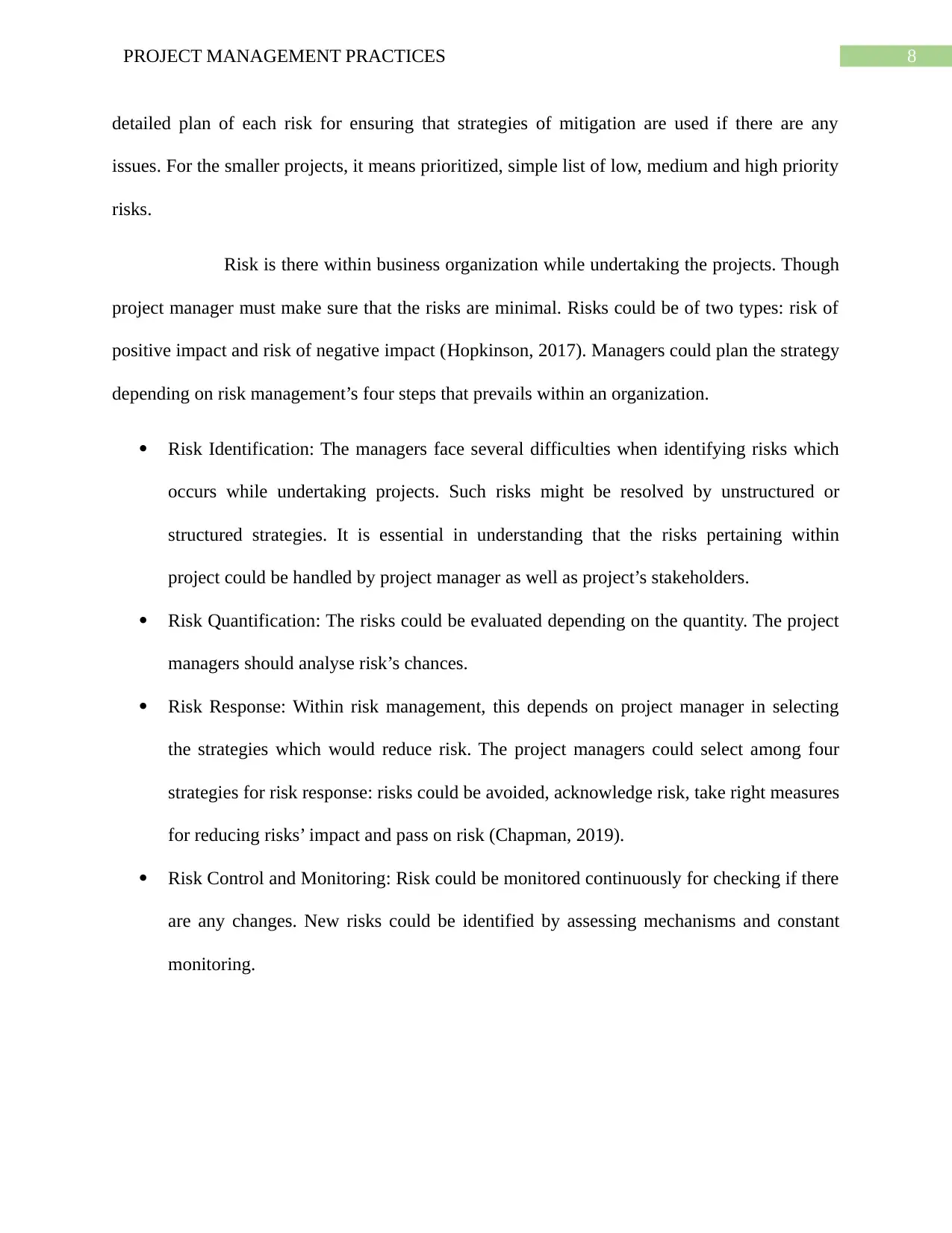
8PROJECT MANAGEMENT PRACTICES
detailed plan of each risk for ensuring that strategies of mitigation are used if there are any
issues. For the smaller projects, it means prioritized, simple list of low, medium and high priority
risks.
Risk is there within business organization while undertaking the projects. Though
project manager must make sure that the risks are minimal. Risks could be of two types: risk of
positive impact and risk of negative impact (Hopkinson, 2017). Managers could plan the strategy
depending on risk management’s four steps that prevails within an organization.
Risk Identification: The managers face several difficulties when identifying risks which
occurs while undertaking projects. Such risks might be resolved by unstructured or
structured strategies. It is essential in understanding that the risks pertaining within
project could be handled by project manager as well as project’s stakeholders.
Risk Quantification: The risks could be evaluated depending on the quantity. The project
managers should analyse risk’s chances.
Risk Response: Within risk management, this depends on project manager in selecting
the strategies which would reduce risk. The project managers could select among four
strategies for risk response: risks could be avoided, acknowledge risk, take right measures
for reducing risks’ impact and pass on risk (Chapman, 2019).
Risk Control and Monitoring: Risk could be monitored continuously for checking if there
are any changes. New risks could be identified by assessing mechanisms and constant
monitoring.
detailed plan of each risk for ensuring that strategies of mitigation are used if there are any
issues. For the smaller projects, it means prioritized, simple list of low, medium and high priority
risks.
Risk is there within business organization while undertaking the projects. Though
project manager must make sure that the risks are minimal. Risks could be of two types: risk of
positive impact and risk of negative impact (Hopkinson, 2017). Managers could plan the strategy
depending on risk management’s four steps that prevails within an organization.
Risk Identification: The managers face several difficulties when identifying risks which
occurs while undertaking projects. Such risks might be resolved by unstructured or
structured strategies. It is essential in understanding that the risks pertaining within
project could be handled by project manager as well as project’s stakeholders.
Risk Quantification: The risks could be evaluated depending on the quantity. The project
managers should analyse risk’s chances.
Risk Response: Within risk management, this depends on project manager in selecting
the strategies which would reduce risk. The project managers could select among four
strategies for risk response: risks could be avoided, acknowledge risk, take right measures
for reducing risks’ impact and pass on risk (Chapman, 2019).
Risk Control and Monitoring: Risk could be monitored continuously for checking if there
are any changes. New risks could be identified by assessing mechanisms and constant
monitoring.
⊘ This is a preview!⊘
Do you want full access?
Subscribe today to unlock all pages.

Trusted by 1+ million students worldwide
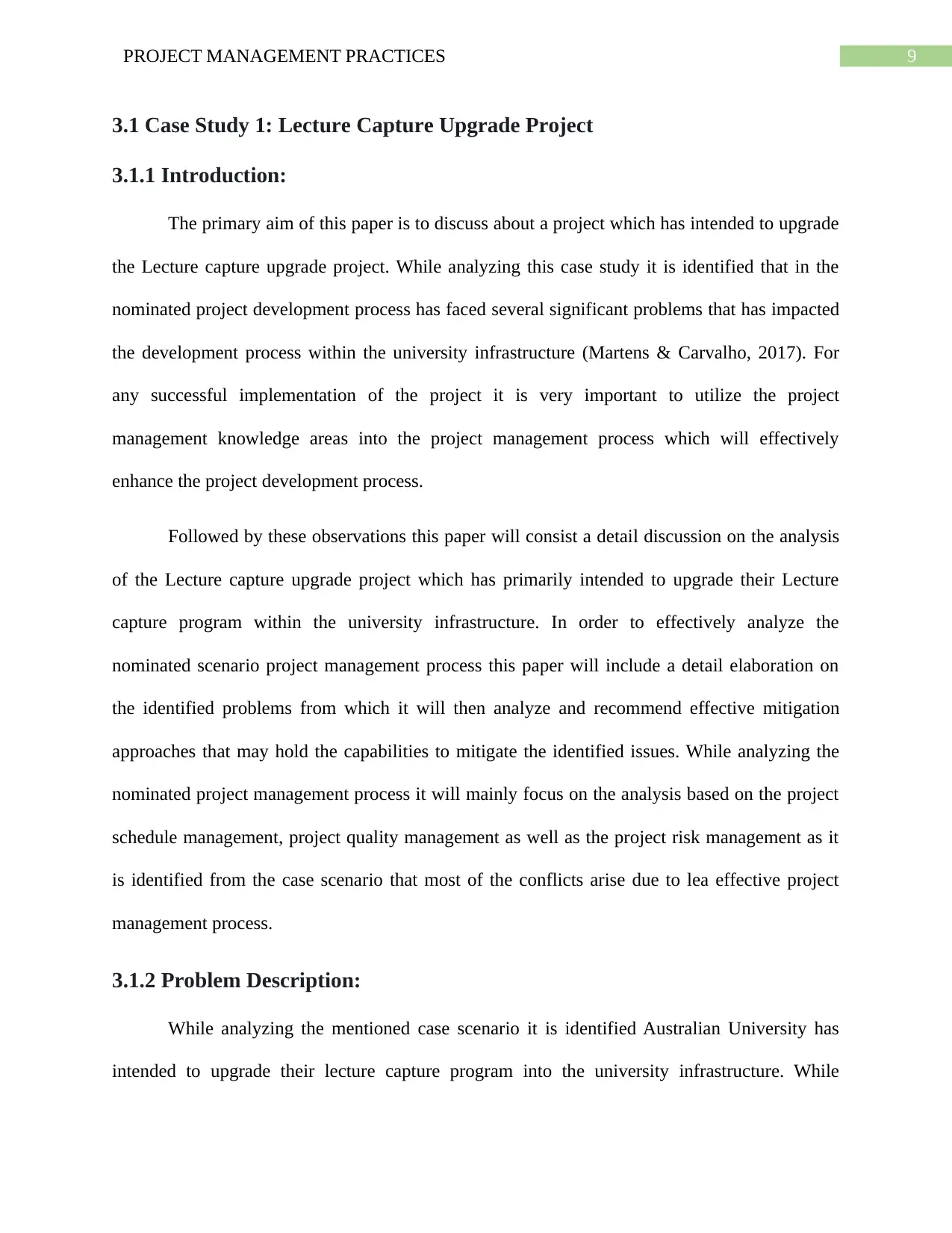
9PROJECT MANAGEMENT PRACTICES
3.1 Case Study 1: Lecture Capture Upgrade Project
3.1.1 Introduction:
The primary aim of this paper is to discuss about a project which has intended to upgrade
the Lecture capture upgrade project. While analyzing this case study it is identified that in the
nominated project development process has faced several significant problems that has impacted
the development process within the university infrastructure (Martens & Carvalho, 2017). For
any successful implementation of the project it is very important to utilize the project
management knowledge areas into the project management process which will effectively
enhance the project development process.
Followed by these observations this paper will consist a detail discussion on the analysis
of the Lecture capture upgrade project which has primarily intended to upgrade their Lecture
capture program within the university infrastructure. In order to effectively analyze the
nominated scenario project management process this paper will include a detail elaboration on
the identified problems from which it will then analyze and recommend effective mitigation
approaches that may hold the capabilities to mitigate the identified issues. While analyzing the
nominated project management process it will mainly focus on the analysis based on the project
schedule management, project quality management as well as the project risk management as it
is identified from the case scenario that most of the conflicts arise due to lea effective project
management process.
3.1.2 Problem Description:
While analyzing the mentioned case scenario it is identified Australian University has
intended to upgrade their lecture capture program into the university infrastructure. While
3.1 Case Study 1: Lecture Capture Upgrade Project
3.1.1 Introduction:
The primary aim of this paper is to discuss about a project which has intended to upgrade
the Lecture capture upgrade project. While analyzing this case study it is identified that in the
nominated project development process has faced several significant problems that has impacted
the development process within the university infrastructure (Martens & Carvalho, 2017). For
any successful implementation of the project it is very important to utilize the project
management knowledge areas into the project management process which will effectively
enhance the project development process.
Followed by these observations this paper will consist a detail discussion on the analysis
of the Lecture capture upgrade project which has primarily intended to upgrade their Lecture
capture program within the university infrastructure. In order to effectively analyze the
nominated scenario project management process this paper will include a detail elaboration on
the identified problems from which it will then analyze and recommend effective mitigation
approaches that may hold the capabilities to mitigate the identified issues. While analyzing the
nominated project management process it will mainly focus on the analysis based on the project
schedule management, project quality management as well as the project risk management as it
is identified from the case scenario that most of the conflicts arise due to lea effective project
management process.
3.1.2 Problem Description:
While analyzing the mentioned case scenario it is identified Australian University has
intended to upgrade their lecture capture program into the university infrastructure. While
Paraphrase This Document
Need a fresh take? Get an instant paraphrase of this document with our AI Paraphraser
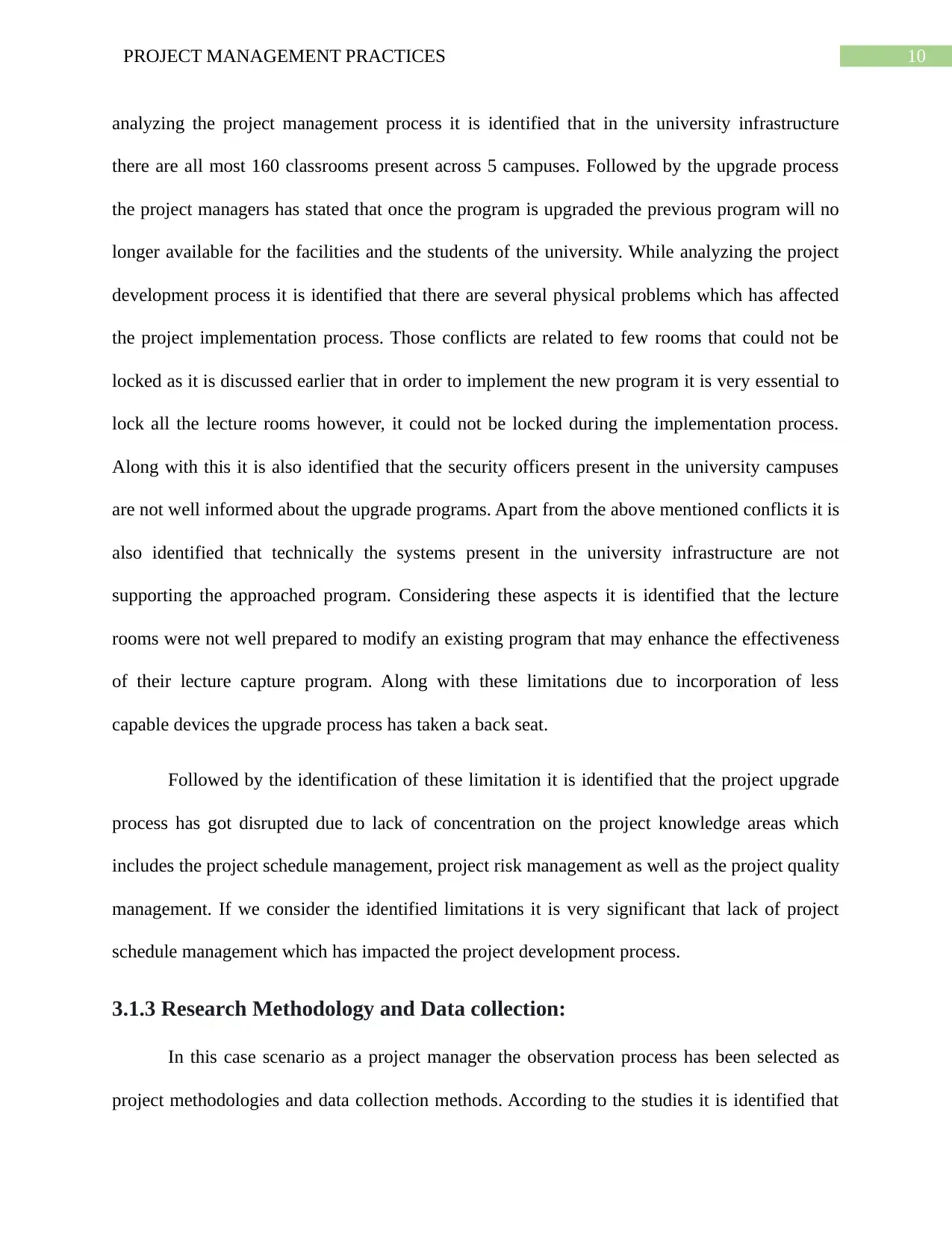
10PROJECT MANAGEMENT PRACTICES
analyzing the project management process it is identified that in the university infrastructure
there are all most 160 classrooms present across 5 campuses. Followed by the upgrade process
the project managers has stated that once the program is upgraded the previous program will no
longer available for the facilities and the students of the university. While analyzing the project
development process it is identified that there are several physical problems which has affected
the project implementation process. Those conflicts are related to few rooms that could not be
locked as it is discussed earlier that in order to implement the new program it is very essential to
lock all the lecture rooms however, it could not be locked during the implementation process.
Along with this it is also identified that the security officers present in the university campuses
are not well informed about the upgrade programs. Apart from the above mentioned conflicts it is
also identified that technically the systems present in the university infrastructure are not
supporting the approached program. Considering these aspects it is identified that the lecture
rooms were not well prepared to modify an existing program that may enhance the effectiveness
of their lecture capture program. Along with these limitations due to incorporation of less
capable devices the upgrade process has taken a back seat.
Followed by the identification of these limitation it is identified that the project upgrade
process has got disrupted due to lack of concentration on the project knowledge areas which
includes the project schedule management, project risk management as well as the project quality
management. If we consider the identified limitations it is very significant that lack of project
schedule management which has impacted the project development process.
3.1.3 Research Methodology and Data collection:
In this case scenario as a project manager the observation process has been selected as
project methodologies and data collection methods. According to the studies it is identified that
analyzing the project management process it is identified that in the university infrastructure
there are all most 160 classrooms present across 5 campuses. Followed by the upgrade process
the project managers has stated that once the program is upgraded the previous program will no
longer available for the facilities and the students of the university. While analyzing the project
development process it is identified that there are several physical problems which has affected
the project implementation process. Those conflicts are related to few rooms that could not be
locked as it is discussed earlier that in order to implement the new program it is very essential to
lock all the lecture rooms however, it could not be locked during the implementation process.
Along with this it is also identified that the security officers present in the university campuses
are not well informed about the upgrade programs. Apart from the above mentioned conflicts it is
also identified that technically the systems present in the university infrastructure are not
supporting the approached program. Considering these aspects it is identified that the lecture
rooms were not well prepared to modify an existing program that may enhance the effectiveness
of their lecture capture program. Along with these limitations due to incorporation of less
capable devices the upgrade process has taken a back seat.
Followed by the identification of these limitation it is identified that the project upgrade
process has got disrupted due to lack of concentration on the project knowledge areas which
includes the project schedule management, project risk management as well as the project quality
management. If we consider the identified limitations it is very significant that lack of project
schedule management which has impacted the project development process.
3.1.3 Research Methodology and Data collection:
In this case scenario as a project manager the observation process has been selected as
project methodologies and data collection methods. According to the studies it is identified that
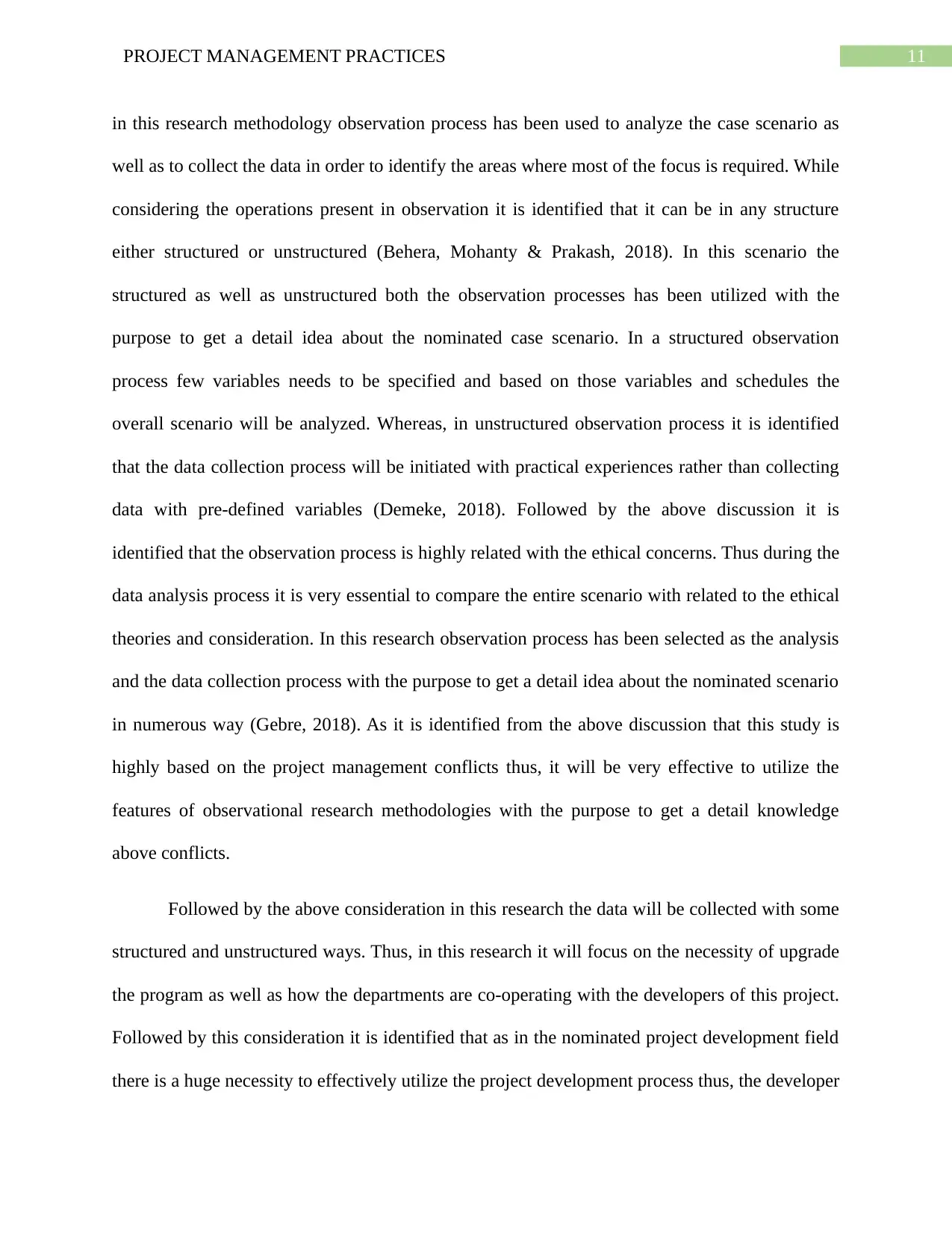
11PROJECT MANAGEMENT PRACTICES
in this research methodology observation process has been used to analyze the case scenario as
well as to collect the data in order to identify the areas where most of the focus is required. While
considering the operations present in observation it is identified that it can be in any structure
either structured or unstructured (Behera, Mohanty & Prakash, 2018). In this scenario the
structured as well as unstructured both the observation processes has been utilized with the
purpose to get a detail idea about the nominated case scenario. In a structured observation
process few variables needs to be specified and based on those variables and schedules the
overall scenario will be analyzed. Whereas, in unstructured observation process it is identified
that the data collection process will be initiated with practical experiences rather than collecting
data with pre-defined variables (Demeke, 2018). Followed by the above discussion it is
identified that the observation process is highly related with the ethical concerns. Thus during the
data analysis process it is very essential to compare the entire scenario with related to the ethical
theories and consideration. In this research observation process has been selected as the analysis
and the data collection process with the purpose to get a detail idea about the nominated scenario
in numerous way (Gebre, 2018). As it is identified from the above discussion that this study is
highly based on the project management conflicts thus, it will be very effective to utilize the
features of observational research methodologies with the purpose to get a detail knowledge
above conflicts.
Followed by the above consideration in this research the data will be collected with some
structured and unstructured ways. Thus, in this research it will focus on the necessity of upgrade
the program as well as how the departments are co-operating with the developers of this project.
Followed by this consideration it is identified that as in the nominated project development field
there is a huge necessity to effectively utilize the project development process thus, the developer
in this research methodology observation process has been used to analyze the case scenario as
well as to collect the data in order to identify the areas where most of the focus is required. While
considering the operations present in observation it is identified that it can be in any structure
either structured or unstructured (Behera, Mohanty & Prakash, 2018). In this scenario the
structured as well as unstructured both the observation processes has been utilized with the
purpose to get a detail idea about the nominated case scenario. In a structured observation
process few variables needs to be specified and based on those variables and schedules the
overall scenario will be analyzed. Whereas, in unstructured observation process it is identified
that the data collection process will be initiated with practical experiences rather than collecting
data with pre-defined variables (Demeke, 2018). Followed by the above discussion it is
identified that the observation process is highly related with the ethical concerns. Thus during the
data analysis process it is very essential to compare the entire scenario with related to the ethical
theories and consideration. In this research observation process has been selected as the analysis
and the data collection process with the purpose to get a detail idea about the nominated scenario
in numerous way (Gebre, 2018). As it is identified from the above discussion that this study is
highly based on the project management conflicts thus, it will be very effective to utilize the
features of observational research methodologies with the purpose to get a detail knowledge
above conflicts.
Followed by the above consideration in this research the data will be collected with some
structured and unstructured ways. Thus, in this research it will focus on the necessity of upgrade
the program as well as how the departments are co-operating with the developers of this project.
Followed by this consideration it is identified that as in the nominated project development field
there is a huge necessity to effectively utilize the project development process thus, the developer
⊘ This is a preview!⊘
Do you want full access?
Subscribe today to unlock all pages.

Trusted by 1+ million students worldwide
1 out of 47
Related Documents
Your All-in-One AI-Powered Toolkit for Academic Success.
+13062052269
info@desklib.com
Available 24*7 on WhatsApp / Email
![[object Object]](/_next/static/media/star-bottom.7253800d.svg)
Unlock your academic potential
Copyright © 2020–2025 A2Z Services. All Rights Reserved. Developed and managed by ZUCOL.



